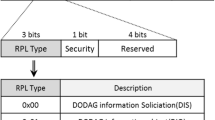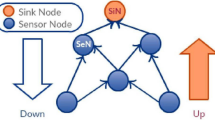Abstract
The Routing Protocol for Low Power Lossy Networks (RPL) is prone to congestion under high traffic. The single-path routing strategy and single-parent selection make RPL energy and resource-efficient only when the traffic is low and uniform. Two Objective Functions (OFs) are defined for RPL, which use single routing metrics-Expected Transmission Count (ETX) and hop count, to select the best parent and path toward the root. However, considering a single metric for OFs is unsuitable for detecting congestion in Lossy Networks (LLNs) applications as each metric has limitations. The current study proposes a novel Multi-Metric Objective Function (MMOF) that combines these two metrics and removes the weakness of the existing OFs. The proposed MMOF works under the nodes' varying transmission ranges (Tx ranges) to reduce the congestion. By changing Tx ranges, we show that the congestion in a fixed topology RPL network reduces, and MMOF can detect this congestion state more accurately than the existing OFs. The research introduces a successful transmission probability metric that makes MMOF more efficient in detecting congestion than ETX and Hop-Count. We prove that considering these two parameters individually is misleading and cannot contribute 100% to detect congestion state. Increasing transmission range can decrease congestion, and MMOF can detect this state transition with 100% accuracy. Simulation results in Cooja show that MMOF outperforms these two metrics and that the robust metric shows a linear relationship with the Tx range. Finally, two quality of service (QoS) parameters are derived to prove the method's efficiency and novelty.









Similar content being viewed by others
Data availability
None.
Code Availability
Not applicable.
References
Iova O, Picco P, Istomin T, Kiraly C. Rpl: The routing standard for the Internet of things… or is it? IEEE Commun Magaz. 2016;54(12):16–22.
Lim C. A survey on congestion control for RPL-based wireless sensor networks. Sensors. 2019;19(11):2567.
Umamaheswari S, Negi A. Internet of Things and RPL routing protocol: A study and evaluation. In2017 International Conference on Computer Communication and Informatics (ICCCI) 2017;1–7
Al-Kashoash HA, Kharrufa H, Al-Nidawi Y, Kemp AH. Congestion control in wireless sensor and 6LoWPAN networks: toward the Internet of Things. Wireless Netw. 2019;25:4493–522.
Brandt A, Hui J, Kelsey R, Levis P, Pister K, Struik R, Vasseur J, Alexander R. RPL: IPv6 routing protocol for low-power and lossy networks. RFC. 2012;6550:1–57.
Gnawali O, Levis P. The minimum rank with hysteresis objective function. 2012.
Thubert P. Objective function zero for the routing protocol for low-power and lossy networks (RPL). 2012.
Tang W, Ma X, Huang J, Wei J. Toward improved RPL: a congestion avoidance multipath routing protocol with time factor for wireless sensor networks. J Sens. 2016;20:16.
Lamaazi H, Benamar N. A comprehensive survey on enhancements and limitations of the RPL protocol: a focus on the objective function. Ad Hoc Netw. 2020;1(96): 102001.
Nait Abbou A, Manner J. ETXRE: energy and delay efficient routing metric for RPL protocol and wireless sensor networks. IET Wireless Sens Syst. 2023;13(6):235–46.
Preeth SS, Dhanalakshmi R, Kumar R, Si S. Efficient parent selection for RPL using ACO and coverage-based dynamic trickle techniques. J Ambient Intell Humaniz Comput. 2020;11:4377–91.
Kaviani F, Soltanaghaei M. CQARPL: congestion and QoS-aware RPL for IoT applications under heavy traffic. J Supercomput. 2022;78(14):16136–66.
Farag H, Österberg P, Gidlund M. Congestion detection and control for 6TiSCH networks in IIoT applications. InICC 2020–2020 IEEE International Conference on Communications (ICC) 2020;1–6. IEEE.
Awan KM, Ashraf N, Saleem MQ, Sheta OE, Qureshi KN, Zeb A, Haseeb K, Sadiq AS. A priority-based congestion-avoidance routing protocol using IoT-based heterogeneous medical sensors for energy efficiency in healthcare wireless body area networks. Int J Distrib Sens Netw. 2019;15(6):1550147719853980.
Hoghooghi S, Javidan R. Proposing a new method for improving RPL to support mobility in the Internet of things. IET Netw. 2020;9(2):48–55.
Gheisari S, Tahavori E. CCCLA: a cognitive approach for congestion control in Internet of Things using a game of learning automata. Comput Commun. 2019;1(147):40–9.
Chowdhury S, Benslimane A, Giri C. Noncooperative gaming for energy-efficient congestion control in 6LoWPAN. IEEE Internet Things J. 2020;7(6):4777–88.
Saleem A, Afzal MK, Ateeq M, Kim SW, Zikria YB. Intelligent learning automata-based objective function in RPL for IoT. Sustain Cities Soc. 2020;1(59): 102234.
Kumar A, Hariharan N. DCRL-RPL: dual context-based routing and load balancing in RPL for IoT networks. IET Commun. 2020;14(12):1869–82.
Venugopal K, Basavaraju TG. Congestion and energy-aware multipath load balancing routing for LLNs. Int J Comput Netw Commun (IJCNC). 2023;15(3):71–92.
Darabkh KA, Al-Akhras M. Improving routing protocol for low-power and lossy networks over IoT environment. In2021 30th Wireless and Optical Communications Conference (WOCC) 2021;31–35. IEEE.
Pushpalatha M, Anusha T, Rao TR, Venkataraman R. L-RPL: RPL powered by laplacian energy for stable path selection during an Internet of Things network link failures. Comput Netw. 2021;15(184): 107697.
Idrees AK, Witwit AJ. Energy-efficient load-balanced RPL routing protocol for Internet of Things networks. Int J Internet Technol Secur Trans. 2021;11(3):286–306.
Aboubakar M, Roux P, Kellil M, Bouabdallah A. A novel scheme for congestion notification in IoT low power networks. In2021 IFIP/IEEE International Symposium on Integrated Network Management (IM) 2021;932–937. IEEE.
Anitha P, Vimala HS, Shreyas J. PQTBA: priority queue based token bucket algorithm for congestion control in IoT network. In2023 IEEE 8th International Conference for Convergence in Technology (I2CT) 2023 Apr 7 (pp. 1–7). IEEE.
Homaei MH, Soleimani F, Shamshirband S, Mosavi A, Nabipour N, Varkonyi-Koczy AR. Using a fuzzy decision system, an enhanced distributed congestion control method for classical 6LowPAN protocols. IEEE Access. 2020;23(8):20628–45.
Hussain SJ, Roopa M. BE-RPL: balanced-load and energy-efficient RPL. Comput Syst Sci Eng. 2023;45:1.
Gupta N, Pughat A, Sharma V. A critical analysis of RPL objective functions in the Internet of things paradigm. Peer-to-Peer Netw Appl. 2021;14(4):2187–208.
Funding
“The authors declare that no funds, grants, or other support were received during the preparation of this manuscript.”
Author information
Authors and Affiliations
Contributions
"All authors contributed to the literature study. Somnath Sinha and Aditi Paul designed the Model and Implementation; Vikas Srivastava performed the result analysis. All the authors read and approved the final manuscript."
Corresponding author
Ethics declarations
Conflict of interests
“The authors have no relevant financial or non-financial interests to disclose.”
Informed consent
None.
Additional information
Publisher's Note
Springer Nature remains neutral with regard to jurisdictional claims in published maps and institutional affiliations.
Rights and permissions
Springer Nature or its licensor (e.g. a society or other partner) holds exclusive rights to this article under a publishing agreement with the author(s) or other rightsholder(s); author self-archiving of the accepted manuscript version of this article is solely governed by the terms of such publishing agreement and applicable law.
About this article
Cite this article
Srivastava, V., Paul, A. & Sinha, S. MMOF: A Multi-Metric Objective Function for Congestion Detection Under Varying Transmission Ranges in RPL-Based WSN. SN COMPUT. SCI. 5, 1112 (2024). https://doi.org/10.1007/s42979-024-03391-2
Received:
Accepted:
Published:
DOI: https://doi.org/10.1007/s42979-024-03391-2




